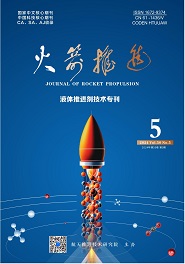航天推进技术研究院主办
[1]陈阳春.25 N双组元发动机热控研究[J].火箭推进,2015,41(02):38-42.
CHEN Yang-chun.Study on thermal control of 25 N bipropellant engine[J].Journal of Rocket Propulsion,2015,41(02):38-42.
点击复制
CHEN Yang-chun.Study on thermal control of 25 N bipropellant engine[J].Journal of Rocket Propulsion,2015,41(02):38-42.
25 N双组元发动机热控研究
《火箭推进》[ISSN:1672-9374/CN:CN 61-1436/V]
卷:
41
期数:
2015年02期
页码:
38-42
栏目:
研究与设计
出版日期:
2015-07-30
- Title:
- Study on thermal control of 25 N bipropellant engine
- 关键词:
- 25 N双组元发动机; I-DEAS/TMG; 热控设计
- Keywords:
- 25 N bipropellant engine; I-DEAS/TMG; thermal control design
- 分类号:
- V434-34
- 文献标志码:
- A
- 摘要:
- 先前的推进系统25 N双组元发动机头部仅一个安装法兰盘,无支架,发动机长时间工作后法兰盘热反浸温度较高,不利于法兰盘上游电磁阀的工作性能。目前推进系统采用双法兰盘支架结构的新型25 N双组元发动机,由于新增支架的隔热,给热控带来了一定难度。在空间极端低温环境下,为使发动机温度满足点火前指标要求,须采取一定的热控措施。以25 N双组元发动机为研究对象,运用I-DEAS/TMG有限元热分析软件,建立了物理模型,研究了大小法兰盘在不同加热功率组合下发动机头部温度场的分布,并根据计算结果选择最佳加热功率组合。同时,根据经验配以适当的被动热控措施。通过飞行试验验证25 N发动机热控设计可靠性高,该热控设计方案可用于其他在研型号的推进系统。
- Abstract:
- 25 N bipropellant engine’s head in the previous propulsion system has only one flange without bracket, so the heat anti-leaching temperature of flange is very high after long time working, which is not conductive to the working performance of the electromagnetic valves at the upstream of the flange. At present, the new 25 N bipropellant engine with the structure of double flanges is used in the propulsion system, but it brings some difficulties to the thermal control due to insulation of the new bracket. In the space of extreme low temperature environment, in order to make the engine temperature meet the index requirements before ignition, it is necessary to make a thermal control measure. In this paper, a 25 N bipropellant engine is taken as the research object, and a physical model is built with the I-DEAS/TMG finite element thermal analysis software to study temperature distribution of the engine head under certain conditions and different combinations of flanges, and to select the best combination of heating power according to the calculated results. At the same time, the appropriate passive thermal control measures are used in accordance with the experience. The result verified in flight test shows that the thermal control design for the 25 N bipropellant engine has high reliability, and can be used for other propulsion systems which are being researched.
参考文献/References:
[1]苏生, 马巨印, 陈阳, 等. 航天器推进系统气路减压阀温度特性研究[J]. 航天器环境工程, 2012, 29(4): 445-449.
[2]李联成, 张萍. 卫星管路加热带安装工艺方法探讨[J]. 航天器环境工程, 2008, 25(4): 384-386.
[3]闵桂荣. 卫星热控制技术[M]. 北京: 宇航出版社, 1991.
[4]胡海峰, 鲍福廷, 蔡强, 等. 液体姿控火箭发动机地面试验热结构分析[J]. 航空动力学报, 2011, 26(2): 442-447.
[5]谭维炽, 胡金刚. 航天器系统工程[M]. 北京: 中国科学技术出版社, 2009.
[6]TMG. I-DEAS 11m1 NX series thermal analysis user's guide[M]. Plano, Texas: UGS PLM Solutions Inc, 2009.
[7]陶文铨. 计算传热学的近代进展[M]. 北京: 科学出版社, 2005.
备注/Memo
收稿日期:2014-09-27;修回日期:2015-01-20 基金项目:上海市科学技术委员会资助课题(13D22250600) 作者简介:陈阳春(1982—),女,工程师,研究领域为航天器热控制技术
更新日期/Last Update:
1900-01-01
